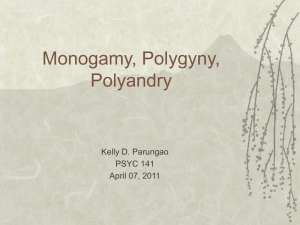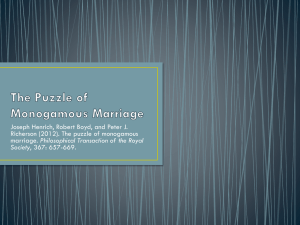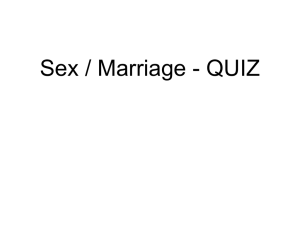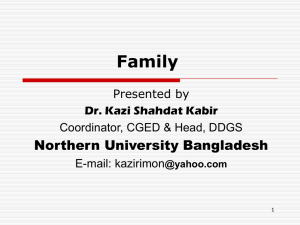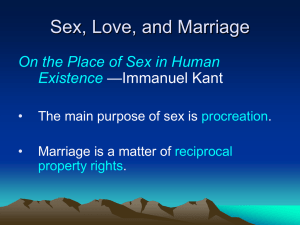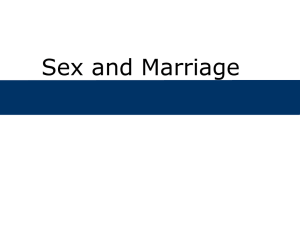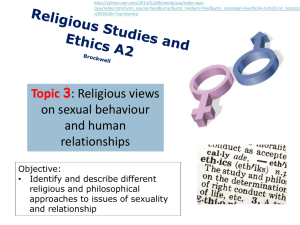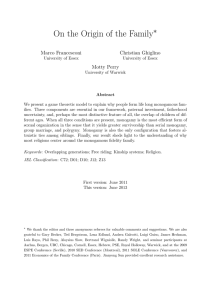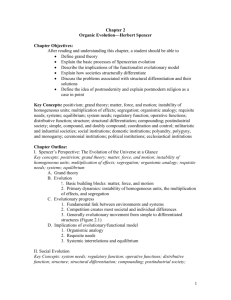topic proposal
advertisement
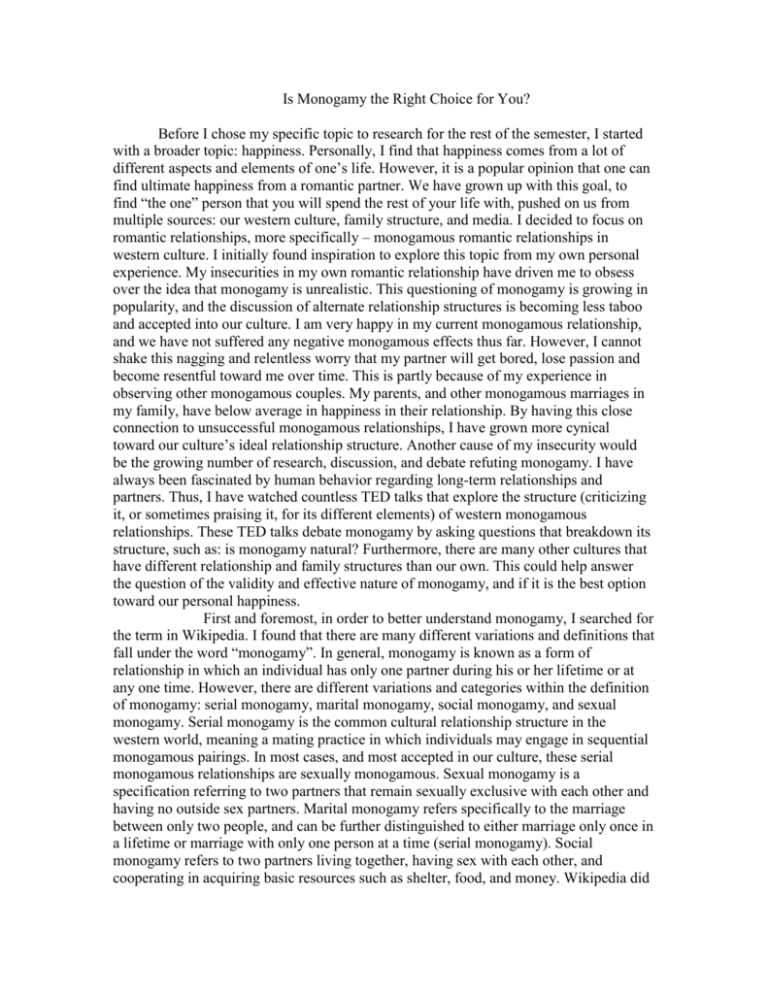
Is Monogamy the Right Choice for You? Before I chose my specific topic to research for the rest of the semester, I started with a broader topic: happiness. Personally, I find that happiness comes from a lot of different aspects and elements of one’s life. However, it is a popular opinion that one can find ultimate happiness from a romantic partner. We have grown up with this goal, to find “the one” person that you will spend the rest of your life with, pushed on us from multiple sources: our western culture, family structure, and media. I decided to focus on romantic relationships, more specifically – monogamous romantic relationships in western culture. I initially found inspiration to explore this topic from my own personal experience. My insecurities in my own romantic relationship have driven me to obsess over the idea that monogamy is unrealistic. This questioning of monogamy is growing in popularity, and the discussion of alternate relationship structures is becoming less taboo and accepted into our culture. I am very happy in my current monogamous relationship, and we have not suffered any negative monogamous effects thus far. However, I cannot shake this nagging and relentless worry that my partner will get bored, lose passion and become resentful toward me over time. This is partly because of my experience in observing other monogamous couples. My parents, and other monogamous marriages in my family, have below average in happiness in their relationship. By having this close connection to unsuccessful monogamous relationships, I have grown more cynical toward our culture’s ideal relationship structure. Another cause of my insecurity would be the growing number of research, discussion, and debate refuting monogamy. I have always been fascinated by human behavior regarding long-term relationships and partners. Thus, I have watched countless TED talks that explore the structure (criticizing it, or sometimes praising it, for its different elements) of western monogamous relationships. These TED talks debate monogamy by asking questions that breakdown its structure, such as: is monogamy natural? Furthermore, there are many other cultures that have different relationship and family structures than our own. This could help answer the question of the validity and effective nature of monogamy, and if it is the best option toward our personal happiness. First and foremost, in order to better understand monogamy, I searched for the term in Wikipedia. I found that there are many different variations and definitions that fall under the word “monogamy”. In general, monogamy is known as a form of relationship in which an individual has only one partner during his or her lifetime or at any one time. However, there are different variations and categories within the definition of monogamy: serial monogamy, marital monogamy, social monogamy, and sexual monogamy. Serial monogamy is the common cultural relationship structure in the western world, meaning a mating practice in which individuals may engage in sequential monogamous pairings. In most cases, and most accepted in our culture, these serial monogamous relationships are sexually monogamous. Sexual monogamy is a specification referring to two partners that remain sexually exclusive with each other and having no outside sex partners. Marital monogamy refers specifically to the marriage between only two people, and can be further distinguished to either marriage only once in a lifetime or marriage with only one person at a time (serial monogamy). Social monogamy refers to two partners living together, having sex with each other, and cooperating in acquiring basic resources such as shelter, food, and money. Wikipedia did not give any clear examples of the term “social monogamy”, therefore I searched for an additional resource to find an example of the difference between social monogamy and its counterparts. I found that this structure is also culturally prevalent in the western world, however some practices of social monogamy differ from the western world’s morals. For example, a socially monogamous relationship is not always also a sexually monogamous relationship. While reading about monogamy on Wikipedia, I found many references throughout the text to terms that describe alternate relationship structures. I discovered that non-monogamous relationship structures that can be found in different cultures are known as polygyny, polyandry, and polyamory. Polygyny is a from of plural marriage, in which a man is allowed more than one wife. Polyandry involves marriage that includes more than two partners and can fall under the broader category of polyamory. Polyamory is the practice, desire, or acceptance of intimate relationships that are not exclusive with respect to other sexual or intimate relationships, with knowledge and consent of everyone involved. Polyamory is becoming more socially acceptable in western culture. After I collected the general definitions essential for my research, I used the Google search engine to find and skim multiple articles debating the topic of monogamy. This allowed me to collect multiple sources I will use for my research, and to discover the most common questions asked about monogamy. And so, with the debate on which relationship structure mentioned above is the most natural and beneficial practice, have come many scientific studies to refute or support the western world’s monogamy. Scientists that study human behavior argue what structure of relationship is most natural to humans according to our biological makeup, how and why monogamy came about, compare different cultural relationship structures to monogamy, and the advantages or disadvantages of monogamy. We are in the midst of a major reformation in our nation, having many of society’s grounded ideologies, beliefs and standards being questioned by the masses. Within this questioning encompasses the topic of western culture’s monogamous relationships, and whether or not it is necessary in our present day. You can find countless TED talks, debates, discussions, research, and studies on monogamy that both support and refute the relationship structure. There are much larger, more serious political and social issues being tackled currently that take on a more urgent, darker debate. The debate on monogamous relationships is a lighter, more curious debate that asks, “What could be?” In order to better understand the topic of monogamous relationships, and whether or not they should phase out or continue, I need to discover when monogamy was introduced into western culture. Once I find the most reliable source of information, I can trace back to the roots of western monogamy and find the reasons for its adoption into western culture. Once I fully understand those reasons, I can compare and contrast them to the current reasons for the continuity of monogamy. Furthermore, I will find information of foreign cultures that practice the extreme ends of the spectrum concerning relationship structures. For example, I will find a culture that practices extreme monogamous relationship standards, and to contrast I will find a culture that practices extreme freedom in relationship standards. This information will allow me to study the positive and negative effects of the culture’s extreme relationship standards, then compare them to western culture’s own positive and negative effects of its relationship standards. This comparison and contrast will allow me to develop a better understanding of relationship structures and their effects on a person’s overall well being, culture and the happiness of the population as a whole. Of course, the topic of romantic relationships also includes the topic of sex. Discussion concerning sex is universally (there are some exceptions, however) taboo, and frequently content related to sex is controversial. Sex is within the scope of the research that I intend to include within my exploration of romantic relationships structures. For example, one of the questions I want to answer with my research is whether the major struggles found in monogamous are sexual needs, emotional needs, or both. However, the topic of sex is not the only controversial topic that comes with researching cultural relationship standards. Religion is a primary aspect of the choices and judgments people make in or about relationships. My first step towards the completion of this journey is to begin my research. Although I am unable to be unbiased as I approach research for this topic, I will attempt to keep an open mind during the research phase of this assignment. It is essential that I credit, analyze, and annotate each of my sources into annotated bibliographies. Second, I will group my annotated bibliographies into similar topic areas and stances that their information encompasses. Finally, once my research is complete, I will decide what idea I will be persuading my audience with my gathered information. The completion of my proposed project will allow myself and others to become more enlightened in their current or future relationships, as well as educated and aware of their own and other culture’s standards. The information I hope to include in my completed project may cause an individual to question their current outlook on their relationships with others for the good – it may improve their personal happiness in life. I am most invested in this researching project because I am determined to find more happiness for myself in life and in my personal romantic relationship. Learning more about and understanding romantic relationships on a higher level may be beneficial to me, and others. Works Cited "Polyandry." Wikipedia. Wikimedia Foundation. Web. 14 Sept. 2015. "Monogamy." Wikipedia. Wikimedia Foundation. Web. 15 Sept. 2015.
